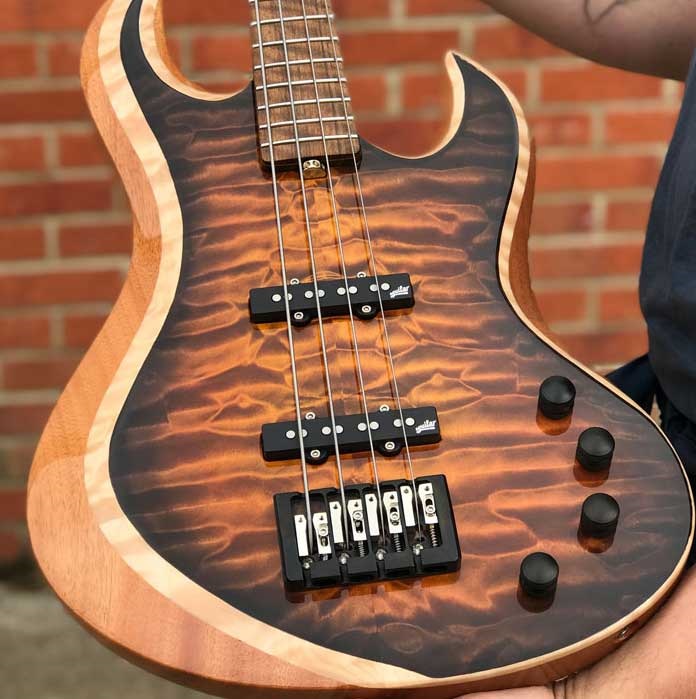Some of you may be aware of the Billy Sheehan Yamaha Attitude bass model (about $2,600 USD street price at the time of this writing) and have wondered what the benefit of having two outputs on a bass has.
As Billy explains in the video below, a lot of it has to do with amp switching where one is matched to the P pickup and the other to the dual-coil neck pickup. The P pickup tone in the way Billy voices pickup-to-amp has almost no bass frequency to it where everything is in the mid and treble end. The neck side dual-coil on the other hand is nothing but bass, so much to the point where you barely hear any string drag when sliding fingers across the strings.
However, Billy also says you can achieve the same two-output effect simply by using a Y-connector cable to split a single output to two amplifiers. So if for example you have a soapbar pickup on the neck side and a P pickup in the middle similar to what Billy has, then yes you can do amp switching to see if it works for you. Also, if you’re currently building your own bass and want faster-than-knob pickup switching, we have plenty of switches to choose from, both 2-way and 3-way.
When watching the video below, Billy does mention his Yamaha bass is more or less modeled after a Fender Precision Bass with a Telecaster Bass neck on it, and does have a Hipshot detuner installed. He also gives other great insights on what he does to get his sound.




Were I still playing professionally in Vegas I think this would be a kewl thing to have.
However I’d do it to my Fender or Schecter because if anyone even looks at my Lincluthier crossways they’d have hell to pay. Lol!
Were I still performing pro in Vegas that would be a kewl thing to happen. However I’d have to install it in my Fender or Schecter, cuz I wouldn’t let anyone touch my LincLuthier!lol
Please ignore first comment they are essentially the same and I thought my iPad lost the first one as I’m having problems with WiFi.
Gee I wonder if Chris Squire was an influence….. especially when it comes to splitting signals.
I’m not a huge fan of Billy Sheehans style, but he sure is one very talented bass player! I think it is awesome how candid he is when he talks about the different components to his rig. He has obviously spent many years and lots of money perfecting the tone he wants and I feel it’s very nice that he shares his knowledge, experience and candid opinions with us!
Rickenbacker had the Stereo outputs back in the 70’s. This is nothing new. My best setup: I would use my Stereo Rick with two Peavey Mark IV 400BH heads, one with a 2 by 10″ speaker cabinet and the other with a 1 by 15″ speaker cabinet. the bridge pickup to the 2 by 10″ and the neck to the 1 by 15″. Then it was a matter of setting up the parametric and graphic EQs for the tone and the room acoustics. The biggest issue is the twin chords… hard enough not to trip on one let alone two… I wound up using electrical tape and zip ties to keep them together.
I play bass to lead the music timing and volume control is king I play delay bass with two mark bass sd 1200 heads with 4 15 and 8 10s no one comes close to my sound and writing I lay worth three drummers two guitars and one keyboard player all these rock bass players thatlay to many notes have no timing and sound controll it makes me laugh all speed no attack I play to make myself proud to be a great musical song writer and not a sellout I dont need the money to sell my music I play my music for the gas I really had a gas
I recently bought a fender mutsang PJ bass that played ME. As a long scale 4 and 5 stringer, I found sounds and playing styles unique to a short scale that expanded my horizons. However, the 2 pickup / 1 volume / 1 tone w / 3-way switch left me wanting tonally. I had my local guitar tech load me with a stacked volume/tone for each pickup and swap the 3/way for a master volume so I can set separate V & T’s and change overall volume w/out losing settings. This arrangement with the master volume left the tone control with the lowest treble level controlling the overall treble level. The solution was to separate the the pickups entirely with a stacked master volume pot with 1 post/knob to a TSR output jack. I run a TSR cable to a Y/splitter into 2 channels of a small mixer (Berringer 802) that I use live (as I use a 5 string and a four string fretless and swap basses during the show without having to unplug / plug in) with one output to my amp (Hartke 3500 & 4-10 cab) . The ability to dial in a low fat “P” and a punchy mid “J” and raise and lower overall volume gives me great satisfaction. I don’t need two separate amps to get two separate pickup tones but would be fun to explore.